 Facebook
Facebook
 X
X
 Instagram
Instagram
 TikTok
TikTok
 Youtube
Youtube
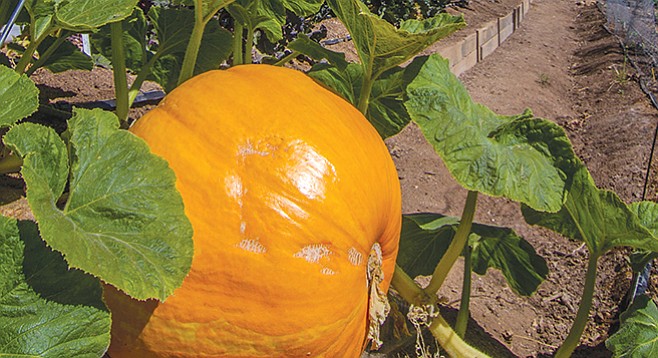
Watlington’s farm
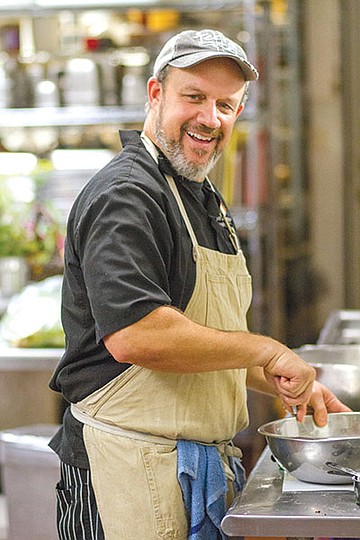
Trish Watlington reaches into a bed of bright red-orange nasturtiums and picks off a couple of whitish green seedpods about the size of wasabi peas. “Here, try it.” She hands one to me and one to chef Jeff Rossman.
“Have you ever tried pickling them?” she asks Rossman. He shakes his head.
I take the pod between my fingers. Watlington looks at me expectantly. “It’s spicy,” she warns. “Like horseradish. Not like painfully spicy.”
As my teeth bite down, the seedpod breaks open and lets loose its bright fresh flavor. It is spicy, but it’s a cool spicy, not at all unpleasant. Rossman eats his, too.
“Oh, it’s good,” he remarks. “You can pickle them?”
“Yeah. They’re kind of like a caper,” Watlington says. “You hot brine them and I think I let them sit in the brine for two days, then you put any pickling solution you want in there.”
“Wow. Cool,” Rossman says. “I gotta try that. They grow wild on my hill.”
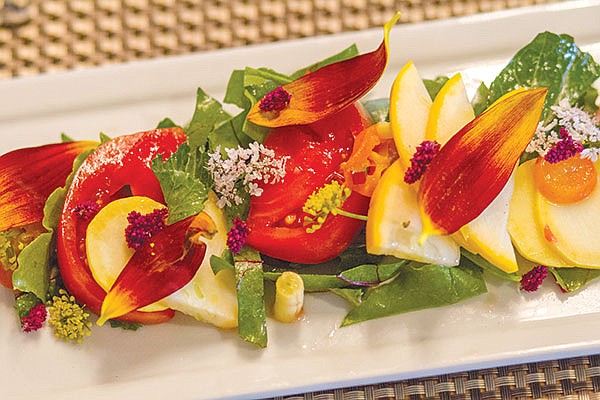
Rossman has invited me along to Two Forks Farm to pick up his week’s order for Terra American Bistro in East San Diego, the El Cajon Boulevard restaurant where he is owner and executive chef. Although Rossman gets his produce from a number of local farms, Two Forks is the newest and most conveniently located — in Mount Helix, less than six miles east of Terra.
The farm itself isn’t new. Watlington used its harvests at Red Door, her own restaurant in Mission Hills, for many years until she finalized its sale earlier this year. Today, the farm supplies local private chefs, small catering companies, and now Terra, its first restaurant outside Red Door.
Watlington and Rossman have known each other through the restaurant industry for many years, and once Watlington stepped away from her restaurant, their relationship evolved naturally into a partnership between farmer and chef.
Most weeks, Watlington sends her list of available vegetables by email on Monday or Tuesday. Rossman chooses items from the list to use for his daily specials and for what he calls the “plate veg,” or vegetables that accompany the entrees. Watlington usually delivers around mid-week, but occasionally, Rossman drives a couple of exits over on the 8 and picks up the order himself.
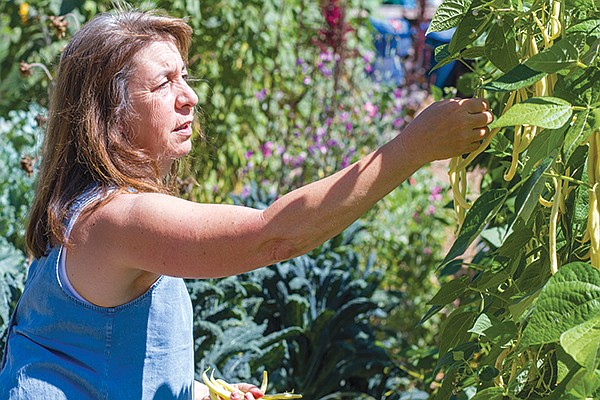
Today, we’re here to pick up French Gold beans, summer squash, kale, fennel, and some edible flowers for this week’s menu. But Watlington is also giving us a tour of the garden so we can see what else is ready to harvest, or will be soon. The sun is bright, and a slight breeze rustles through the greenery. Hummingbirds and slow fat bees go about their business around us.
This suburban farm occupies approximately a half-acre of what used to be a mustard field on Watlington’s 1.75-acre property. Currently, she’s growing more than 50 varieties of vegetables, fruits, and edible flowers and herbs, including five types of tomatoes with names such as Pineapple, Big Beef, and Sweet 100; a small purple eggplant called Japanese Millionaire, and a cucumber called Diva. Some of the plants, strawberries for instance, grow close to the ground, while others such as the Burgundy and Mammoth Sunflowers grow as high as three feet over Watlington’s 5’0” frame. The fruiting trees on the property include naval orange, Meyer lemon, Anna apple, pomelo, four varieties of figs, avocado, grapefruit, persimmon, pomegranate, and lime.
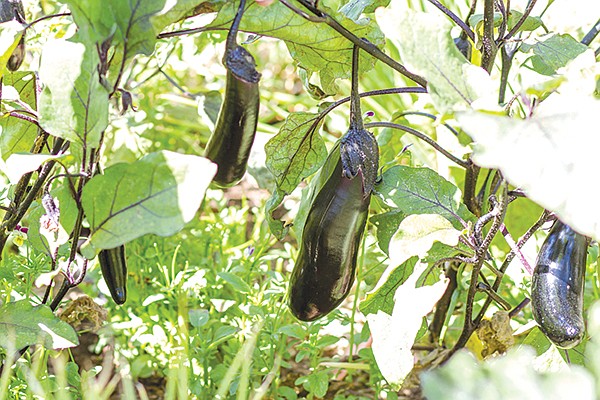
“It produces pretty heavily,” she says of the farm. “If we take care of it well and plant efficiently, we can get about six or seven thousand pounds of vegetables per year, not counting the citrus fruits.”
We take a moment to listen to the birds and the wind in the trees and to marvel at the bounty.
“It really is magical,” she says. “I am a crazed nut for root crops, because it’s so much fun to pull them out of the ground and see what you get. It’s like a birthday present every time you harvest. Carrots and beets and even fennel root.”
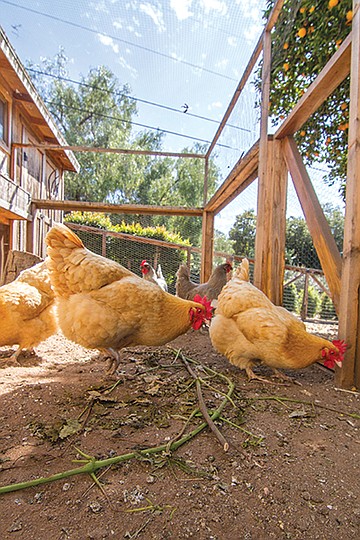
As we walk up and down the rows, Watlington scans the area for small tasks that need doing. She pulls the bottom leaves off a row of kalette plants, a kale-Brussels sprouts hybrid. She messes with an irrigation hose. She picks a vegetable off a stem or a vine and hands it to me to smell or taste. Under her guidance, the farm becomes a series of sensations. The crunch and sweetness of a French Gold bean. The pungent floral-herbal fragrance of Cleveland sage. The licorice flavor of fennel pollen straight from the flower.
At one point, she hands Chef Rossman a small container and tells him to gather any edible flowers he’d like. She points to the purple-veined leaves and dark purple fruit of Japanese Millionaire eggplant and warns him that although the bright purple flowers are pretty, they’re in the nightshade family and highly poisonous.
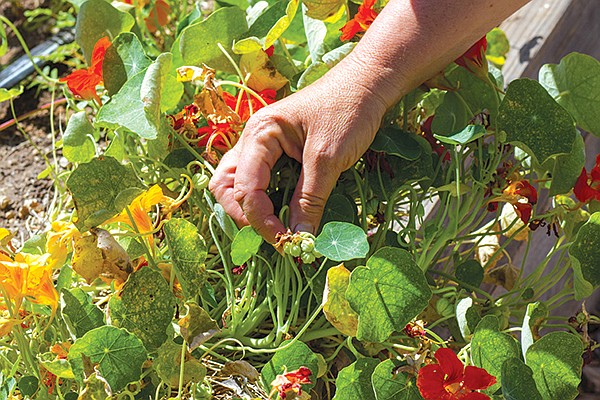
Within a few minutes, Rossman has filled the container with two flat-topped clusters of pale yellow fennel flowers, three golden yellow disc-like calendula flower heads, 10 or so orange-yellow and red-orange nasturtium flowers, a few teeny tiny purple and yellow Johnny Jump Up violets, and a small cluster of lacy white carrot top flowers.
“We could make a salad just with flowers,” Rossman says.
“I love flower salad,” Watlington responds.
Knowing where the food comes from
“It’s all about knowing the farmer and knowing where the food comes from,” Rossman says.
The collaborative nature of Rossman and Watlington’s relationship becomes apparent when he says, “I want to do some of those leaves you were talking about,” clearly continuing a conversation they’d started earlier. “That sounds super intriguing.”
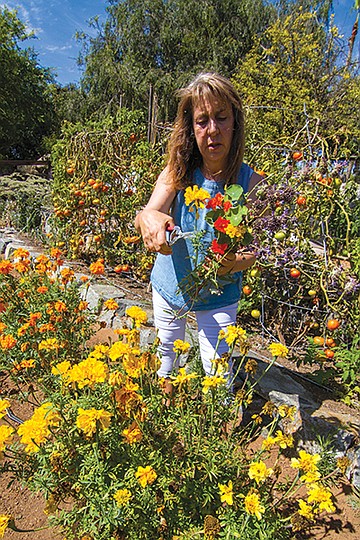
“Oh, you mean the sunflower leaves?” Watlington says, turning toward a tall row of sunflower stalks nearly eight feet high. When he confirms, she adds, “Yeah, this is the perfect time to get them because a month from now they’ll be not tender enough.”
“To eat?” I interject.
“To stuff ‘em,” Rossman says in a lusty voice.
“You can make them like you would a grape leaf, like dolma?” Watlington says. “You can stuff them with whatever you want and roll them up and eat them. They’re delicious.”
“That’d be awesome,” Rossman says.
The length of time during which the leaves are tender enough isn’t very long, she explains, informing Rossman that he should probably get them this week or next if he wants to use them. He says he’ll probably want three dozen or so next week, which if he uses three per order will give him about 12 orders, just the right for a daily special.
“When you partner with a farmer,” Watlington says, “you get to try new things that nobody else has on their menu.”
“Like sunflower leaves and carrot flowers,” he says, pointing to tall weedy looking plant topped with tiny white clusters of flowers.
The single plant is the only thing currently growing in the 10-by-4-foot raised bed, and Watlington explains that there’s likely an improperly formed carrot beneath the soil that gave all its energy to flowering.
“I left it because white flowers encourage beneficial insects,” she says. “For example, there’s a beneficial wasp that lays its eggs in the body of destructive caterpillars. It’s a predatory wasp, and it obviously kills the caterpillar.”
“That’s cool,” Rossman says.
The rest of the bed that contains the carrot flowers is empty except for four black 5/8-inch John Deere drip irrigation tubes running over the top of 2.5 cubic yards of soil composed of a 60/40 compound/topsoil mix. Watlington is saving the bed for Terra.
“We’re going to have a meeting next week to talk about what Chef might want to plant here for fall,” she says. “But in terms of the bigger space, we can also talk about what I might grow for him that he might want on his menu every week. So, that’ll be a fun collaboration.”
Rossman explains that it’s not just about telling Watlington what he wants but also consulting her about what will grow best. Then, he can plan his fall menu around it. And if she can guarantee that she’ll have enough of whatever it is to carry him through the season’s menu, he’ll be able to print “Two Forks Farm Brussels sprouts” or whatever it is, on his menu.
“But this is the part that gets tricky about menuing,” he says. “If I can’t get Two Forks Farm Brussels sprouts and I have to go to Specialty Produce, now it’s a misnomer. And I have to change my menu, which costs money.”
The items on the menu at Terra come from local farms, but the seasonal menu says, “Local vegetables,” and then he tells the servers on a daily basis what the vegetables of day are, and which farms they’re from. It doesn’t always change, though. Some things will stay the same for a few days, depending on how much of any given item he has.
Some of the obstacles to running a farm-to-table restaurant, Rossman says, “include availability, seasonality, and product utilization. Unfortunately, there are a lot of farms that do the same things. A lot of farms do lettuces, herbs, tomatoes. So you want to find more obscure farms that are doing other things, or someone like Trish, where they’re like, ‘I’ll grow for you.’ That’s super cool.”
Watlington points to the wide leaves of a bed of tromboncino squash, and says, “I’m trying to convince Jeff that he wants to use tromboncino squash this year instead of zucchini.”
“For sure,” he says.
The fight against farm-to-table fraud
Although Terra is the only restaurant Watlington’s farm is currently supplying, she’s hoping to continue to expand her relationship with other restaurants that have expressed interest.
“Smaller ones,” she specifies. “Big restaurants are harder to work with because, A, they’re not very flexible with their menus, and B, I don’t have the amount that will cover what they need.”
Beyond the relationships her own farm has with local restaurants, Watlington fights what she calls “farm-to-fable” or “farm-to-table fraud” in San Diego. So she began working on the Farm to Fork initiative, an organization that allows farmers to verify farm-to-table restaurants.
The requirements for verification include at least one consistent weekly or biweekly relationship with a local farm. At this point, Watlington is the organization, and the only way for a restaurant to verify its relationship with a farm is for the farmer to tell her directly.
“As much as I love chefs and restaurants, I don’t take anybody’s word for it,” she says.
Rossman laughs.
Having a relationship with Specialty Produce, the wholesale distributor that provides restaurants with local produce, does not count, though. This decision wasn’t one the organization came to easily.
“There’s no way to completely 100-percent supply a restaurant from local farms. And sometimes you just want something that isn’t on a local farm,” Watlington says. “[Specialty Produce] also gives farmers an outlet for their produce, especially farmers who don’t want to sell directly to local chefs because it’s a pain in the butt. You have to invoice people. You have to make sure you collect from them. Not all chefs are wonderful at paying.”
But after multiple meetings discussing the topic, the organization decided that purchasing local fruits and vegetables through Specialty Produce does not fulfill the farm-to-fork verification requirement.
“We felt like the point of this organization would be the relationship building between farmers and chefs,” she says.
On the Farm to Fork Week website, restaurant partners promise to include a special prix fixe meal or a specially priced dish that includes items from partner farms during the semi-annual Farm to Fork Weeks, social media engagement around Farm to Fork Week with other restaurants, farms, and media partners, and a $150 fee for website maintenance and other organizational expenses.
The organization began when Watlington reached out to a group of “tiny restaurant friends” who came together to support each other rather than participating in (and paying the fee for) San Diego Restaurant Week. They decided to create special menus, promote each other, and promote the fact that they were locally sourced. They decided to hold the first Farm to Fork week during the Restaurant Week in January 2016, which stirred up some controversy and subsequently increased restaurant interest and participation in the small group’s mission.
Ten to 12 restaurants participated in the first Farm to Fork Week, and the number went up to 23 in January of this year, but as of this writing, it’s back down to 20, because some of the previous participants no longer fulfill the requirements.
The Farm to Fork San Diego organization is still evolving and growing based on the input of farmers, chefs, wineries, media partners, Farm Bureau representatives, and industry non-profit organizations. Currently, their Facebook page has a survey link to gather input about the organization’s structure, membership requirements, and benefits.
Watlington says she spends approximately 30 percent of her time in the garden, 30 percent working on Farm to Fork tasks, and the other 40 percent split between family time and advisory boards.
Rossman’s Fork
Before we leave, Watlington walks us back through the garden gate that leads to a fenced-in yard between the house and the farm. As we pass a 12-by-4-foot chicken coop that houses five Orpington chickens, which she calls “the golden retriever of chickens,” she tosses the kalette leaves in. The chickens scramble over and start pecking at them. She leads us through another gate onto a large patio with a swimming pool and an outdoor kitchen where she opens a large refrigerator stuffed full of harvested vegetables and retrieves a cardboard box of large dark green kale leaves, a garbage-bag sized plastic bag full of fennel, and two smaller bags, one holding bright yellow summer squash and the other full of French Gold beans.
Rossman puts the fennel in his crate with the smaller box of edible flowers and piles the box of kale on top of the crate. Before heading to the car, we follow Watlington back into the farm so she can double check the weight of the squash and beans on a small scale sitting on a garden table. She confirms four and a half pounds of beans and four pounds of squash, which she will add to Terra’s invoice for the week.
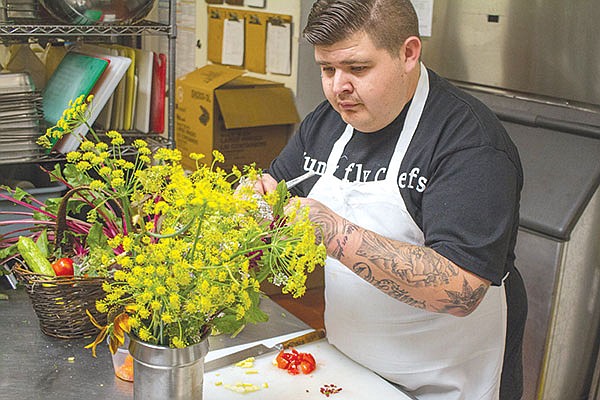
Back in La Mesa, we enter the restaurant through the kitchen’s back door, and Rossman places the box of fennel, squash, and beans on a stainless steel table. Chef Michael Rubalcava, Terra’s lead line cook, heads over and sticks his hand in the bag of beans, pulls one out, snaps off its ends, and takes a bite. Rossman unpacks the crate and shows all his bounty, and the two begin to talk specials.
“I also got a whole bunch of really cool flowers,” Rossman says, “and I thought we could take some of the squash…”
“I think I have some carrot-top pesto,” Rubalcava says, chewing on the bean and reaching his hand into the bag for more, “and we could maybe toss the veggies and the squash.”
“We could do that,” Rossman says. “Or we could use some of that chili lime watermelon vinaigrette, and we could do a small plate. We could even take a mandolin, and shave the radish, and maybe do a little fennel on top of that with the flowers.”
For the next couple of minutes, the two chefs go back and forth, discussing the evening specials based on what’s come in from the farm and what’s already available in the kitchen. Rossman suggests using the carrot-top pesto on tuna and Rubalcava counters with a coconut-miso broth. Rossman likes the idea, suggests adding fennel on top, and then moves on to the day’s special pasta. When Rossman heads to the office to type up the specials, Rubalcava, who has been munching on the beans during the whole conversation, says, “At every job I’ve worked, when I’ve had these at my station, I usually run out. Not because we sell them, but because I eat them. When I’m waiting for orders, I just snack on them.”
Rubalcava sets up his station by placing a bowl of julienned jicama and purple pickled cabbage next to his square green, high-density polyethylene plastic cutting board. Beside the bowl, he places a beaker holding a lemon and a small bunch of micro cilantro, which does not have the soapy quality of mature cilantro that some people despise. He places a cup containing three 8- to 10-inch summer squash beside the cilantro.
“Mise en place,” he explains: everything in place.
After washing a large bunch of fennel in a sink a few steps away, he lays it across the cutting board and uses a 10-inch Miyabi chef’s knife to remove the tops. These he puts aside for garnish.
“One thing we try to do here is to utilize the whole product,” he says while he cuts into the fennel bulb. He puts a large piece aside and informs me that he’ll shave it with the mandolin to go in the salad. He cuts the rest into wedges, removes the core from each, and begins to slice and julienne them for the slaw.
Rossman comes over with the day’s specials menu printed on a half sheet of paper bearing the Terra logo up top. He places it beside the cutting board and reads it aloud to Rubalcava who continues working the fennel.
pork shoulder taco
jicama-fennel slaw, pickled cabbage
remoulade, micro cilantro 3
farmer’s salad
two forks farm shaved summer squash & fennel
stehly organics green strawberries, kumquats
chile-lime watermelon vinaigrette 8
togarashi seared line caught yellowfin tuna
coconut-miso broth, chille oil 11
brandt beef ribeye pasta
pan seared ribeye, pork belly bites, white beech & shitake mushrooms, feuttuccini, kale, French gold beans
smoked gouda cream sauce 19.95
“So, you just did that just now?” I ask him.
“Well, we’ve been talking about it for the last two hours,” he says, laughing.
Rubalcava moves on from the fennel to the cilantro, giving it a rough chop and tossing it into the bowl with the jicama, cabbage, and now the fennel. Around us, the kitchen bustles with preparations. Every couple of minutes, someone new comes in through the back door, tying on an apron and announcing their presence with a general greeting for all. The dining room will open for service in about a half hour. Sarah Gonzalez, the bartender, comes into the kitchen, opens the ice machine and scoops ice into the bucket she carries. Someone whistles.
“I think this one came from someone’s farm or someone’s house,” Rubalcava says, holding up a lemon. “Hey, Chef! Where did this come from?”
“What is that?” Rossman says, squinting from the other side of the kitchen.
“A Meyer lemon,” Rubalcava responds.
“Is that from Tobey?” Gonzalez asks at the same time that Rossman says, “Oh, it’s from Tobey. Same with the kumquats.”
“Yeah, so people donate produce sometimes,” Rubalcava tells me.
“Tobey comes in every week on Sunday,” Gonzalez says, still shoveling ice into her bucket. “They’ve been coming in every week for years. So one day, she came in and she said, ‘Can you use these?’ It was lemons, kumquats, and blood oranges. Some days, I’ll use them for drink specials and I’ll name them after her.”
“We have an abundance of kumquats [from Tobey],” Rubalcava says. “So what I’ll probably do is maybe make a jam out of them for Sunday brunch.”
After tossing the slaw ingredients together he puts some in a small container for me to taste.
“It’s just simple and fresh,” he says. “There’s no recipe. We just use what we have.”
He leans over to consult the specials menu.
“So I’ll get this into a container, put it on the line, and then get to work on the farmer’s salad,” he says. I watch as he adds a container of green strawberries, a small cup of kumquats, and the prepared fennel bulb next to the summer squash.
“Mise en place,” he says again. “We live and die by it.”
He places a stainless steel MIU France mandolin slicer on top of the cutting board and begins the process of shaving the fennel. It falls from the mandolin onto the cutting board in thin, translucent slices that he places in a cup of water and ice to help retain their crunch.
Rossman, who has just helped his catering team finish up an order headed for a yacht down by the Sheraton, brings the container of flowers over to the work table and begins to pull them out one by one, washing them gently in a small bowl of water and then laying them out to dry. They make a bright display against the stainless steel.
During the rest of the dinner prep process, Rossman and Rubalcava both go about their business around me, discussing the preferred thickness of the squash slices, pulling the petals off of flowers, shaving fennel, and handling other kitchen duties. While they work, they offer me small tastes of the sweet-on-the-outside-sour-on-the-inside kumquats, super thin slices of fennel, and more of those freshly picked yellow wax beans cut into thirds.
Rubalcava confirms with Rossman that the salad will be composed, rather than tossed, and then explains to me that this means it will help maintain the “integrity of the vegetables.”
“The next part is the plating,” Rossman says, going on to explain that he doesn’t usually know what he’ll with the dishes presentation-wise. He plays with the first one a little bit, fiddles with it until it looks good, and then uses that as the template for the dish for the rest of the evening.
Out in the dining room 30 minutes later, I order the pork shoulder taco, the farmer’s salad, and the pasta. Trese Conklin-Johnson, the floor manager, brings my salad first. The eighth-inch thick squash circles have been arranged in a circle around a small pile of shaved fennel topped with two halves of green strawberry and adorned with flower petals and equally thin slices of kumquat. It’s a bright, summery, and highly instagrammable dish. So I take a photo. And then I dig in.


Watlington’s farm

Trish Watlington reaches into a bed of bright red-orange nasturtiums and picks off a couple of whitish green seedpods about the size of wasabi peas. “Here, try it.” She hands one to me and one to chef Jeff Rossman.
“Have you ever tried pickling them?” she asks Rossman. He shakes his head.
I take the pod between my fingers. Watlington looks at me expectantly. “It’s spicy,” she warns. “Like horseradish. Not like painfully spicy.”
As my teeth bite down, the seedpod breaks open and lets loose its bright fresh flavor. It is spicy, but it’s a cool spicy, not at all unpleasant. Rossman eats his, too.
“Oh, it’s good,” he remarks. “You can pickle them?”
“Yeah. They’re kind of like a caper,” Watlington says. “You hot brine them and I think I let them sit in the brine for two days, then you put any pickling solution you want in there.”
“Wow. Cool,” Rossman says. “I gotta try that. They grow wild on my hill.”

Rossman has invited me along to Two Forks Farm to pick up his week’s order for Terra American Bistro in East San Diego, the El Cajon Boulevard restaurant where he is owner and executive chef. Although Rossman gets his produce from a number of local farms, Two Forks is the newest and most conveniently located — in Mount Helix, less than six miles east of Terra.
The farm itself isn’t new. Watlington used its harvests at Red Door, her own restaurant in Mission Hills, for many years until she finalized its sale earlier this year. Today, the farm supplies local private chefs, small catering companies, and now Terra, its first restaurant outside Red Door.
Watlington and Rossman have known each other through the restaurant industry for many years, and once Watlington stepped away from her restaurant, their relationship evolved naturally into a partnership between farmer and chef.
Most weeks, Watlington sends her list of available vegetables by email on Monday or Tuesday. Rossman chooses items from the list to use for his daily specials and for what he calls the “plate veg,” or vegetables that accompany the entrees. Watlington usually delivers around mid-week, but occasionally, Rossman drives a couple of exits over on the 8 and picks up the order himself.

Today, we’re here to pick up French Gold beans, summer squash, kale, fennel, and some edible flowers for this week’s menu. But Watlington is also giving us a tour of the garden so we can see what else is ready to harvest, or will be soon. The sun is bright, and a slight breeze rustles through the greenery. Hummingbirds and slow fat bees go about their business around us.
This suburban farm occupies approximately a half-acre of what used to be a mustard field on Watlington’s 1.75-acre property. Currently, she’s growing more than 50 varieties of vegetables, fruits, and edible flowers and herbs, including five types of tomatoes with names such as Pineapple, Big Beef, and Sweet 100; a small purple eggplant called Japanese Millionaire, and a cucumber called Diva. Some of the plants, strawberries for instance, grow close to the ground, while others such as the Burgundy and Mammoth Sunflowers grow as high as three feet over Watlington’s 5’0” frame. The fruiting trees on the property include naval orange, Meyer lemon, Anna apple, pomelo, four varieties of figs, avocado, grapefruit, persimmon, pomegranate, and lime.

“It produces pretty heavily,” she says of the farm. “If we take care of it well and plant efficiently, we can get about six or seven thousand pounds of vegetables per year, not counting the citrus fruits.”
We take a moment to listen to the birds and the wind in the trees and to marvel at the bounty.
“It really is magical,” she says. “I am a crazed nut for root crops, because it’s so much fun to pull them out of the ground and see what you get. It’s like a birthday present every time you harvest. Carrots and beets and even fennel root.”

As we walk up and down the rows, Watlington scans the area for small tasks that need doing. She pulls the bottom leaves off a row of kalette plants, a kale-Brussels sprouts hybrid. She messes with an irrigation hose. She picks a vegetable off a stem or a vine and hands it to me to smell or taste. Under her guidance, the farm becomes a series of sensations. The crunch and sweetness of a French Gold bean. The pungent floral-herbal fragrance of Cleveland sage. The licorice flavor of fennel pollen straight from the flower.
At one point, she hands Chef Rossman a small container and tells him to gather any edible flowers he’d like. She points to the purple-veined leaves and dark purple fruit of Japanese Millionaire eggplant and warns him that although the bright purple flowers are pretty, they’re in the nightshade family and highly poisonous.

Within a few minutes, Rossman has filled the container with two flat-topped clusters of pale yellow fennel flowers, three golden yellow disc-like calendula flower heads, 10 or so orange-yellow and red-orange nasturtium flowers, a few teeny tiny purple and yellow Johnny Jump Up violets, and a small cluster of lacy white carrot top flowers.
“We could make a salad just with flowers,” Rossman says.
“I love flower salad,” Watlington responds.
Knowing where the food comes from
“It’s all about knowing the farmer and knowing where the food comes from,” Rossman says.
The collaborative nature of Rossman and Watlington’s relationship becomes apparent when he says, “I want to do some of those leaves you were talking about,” clearly continuing a conversation they’d started earlier. “That sounds super intriguing.”

“Oh, you mean the sunflower leaves?” Watlington says, turning toward a tall row of sunflower stalks nearly eight feet high. When he confirms, she adds, “Yeah, this is the perfect time to get them because a month from now they’ll be not tender enough.”
“To eat?” I interject.
“To stuff ‘em,” Rossman says in a lusty voice.
“You can make them like you would a grape leaf, like dolma?” Watlington says. “You can stuff them with whatever you want and roll them up and eat them. They’re delicious.”
“That’d be awesome,” Rossman says.
The length of time during which the leaves are tender enough isn’t very long, she explains, informing Rossman that he should probably get them this week or next if he wants to use them. He says he’ll probably want three dozen or so next week, which if he uses three per order will give him about 12 orders, just the right for a daily special.
“When you partner with a farmer,” Watlington says, “you get to try new things that nobody else has on their menu.”
“Like sunflower leaves and carrot flowers,” he says, pointing to tall weedy looking plant topped with tiny white clusters of flowers.
The single plant is the only thing currently growing in the 10-by-4-foot raised bed, and Watlington explains that there’s likely an improperly formed carrot beneath the soil that gave all its energy to flowering.
“I left it because white flowers encourage beneficial insects,” she says. “For example, there’s a beneficial wasp that lays its eggs in the body of destructive caterpillars. It’s a predatory wasp, and it obviously kills the caterpillar.”
“That’s cool,” Rossman says.
The rest of the bed that contains the carrot flowers is empty except for four black 5/8-inch John Deere drip irrigation tubes running over the top of 2.5 cubic yards of soil composed of a 60/40 compound/topsoil mix. Watlington is saving the bed for Terra.
“We’re going to have a meeting next week to talk about what Chef might want to plant here for fall,” she says. “But in terms of the bigger space, we can also talk about what I might grow for him that he might want on his menu every week. So, that’ll be a fun collaboration.”
Rossman explains that it’s not just about telling Watlington what he wants but also consulting her about what will grow best. Then, he can plan his fall menu around it. And if she can guarantee that she’ll have enough of whatever it is to carry him through the season’s menu, he’ll be able to print “Two Forks Farm Brussels sprouts” or whatever it is, on his menu.
“But this is the part that gets tricky about menuing,” he says. “If I can’t get Two Forks Farm Brussels sprouts and I have to go to Specialty Produce, now it’s a misnomer. And I have to change my menu, which costs money.”
The items on the menu at Terra come from local farms, but the seasonal menu says, “Local vegetables,” and then he tells the servers on a daily basis what the vegetables of day are, and which farms they’re from. It doesn’t always change, though. Some things will stay the same for a few days, depending on how much of any given item he has.
Some of the obstacles to running a farm-to-table restaurant, Rossman says, “include availability, seasonality, and product utilization. Unfortunately, there are a lot of farms that do the same things. A lot of farms do lettuces, herbs, tomatoes. So you want to find more obscure farms that are doing other things, or someone like Trish, where they’re like, ‘I’ll grow for you.’ That’s super cool.”
Watlington points to the wide leaves of a bed of tromboncino squash, and says, “I’m trying to convince Jeff that he wants to use tromboncino squash this year instead of zucchini.”
“For sure,” he says.
The fight against farm-to-table fraud
Although Terra is the only restaurant Watlington’s farm is currently supplying, she’s hoping to continue to expand her relationship with other restaurants that have expressed interest.
“Smaller ones,” she specifies. “Big restaurants are harder to work with because, A, they’re not very flexible with their menus, and B, I don’t have the amount that will cover what they need.”
Beyond the relationships her own farm has with local restaurants, Watlington fights what she calls “farm-to-fable” or “farm-to-table fraud” in San Diego. So she began working on the Farm to Fork initiative, an organization that allows farmers to verify farm-to-table restaurants.
The requirements for verification include at least one consistent weekly or biweekly relationship with a local farm. At this point, Watlington is the organization, and the only way for a restaurant to verify its relationship with a farm is for the farmer to tell her directly.
“As much as I love chefs and restaurants, I don’t take anybody’s word for it,” she says.
Rossman laughs.
Having a relationship with Specialty Produce, the wholesale distributor that provides restaurants with local produce, does not count, though. This decision wasn’t one the organization came to easily.
“There’s no way to completely 100-percent supply a restaurant from local farms. And sometimes you just want something that isn’t on a local farm,” Watlington says. “[Specialty Produce] also gives farmers an outlet for their produce, especially farmers who don’t want to sell directly to local chefs because it’s a pain in the butt. You have to invoice people. You have to make sure you collect from them. Not all chefs are wonderful at paying.”
But after multiple meetings discussing the topic, the organization decided that purchasing local fruits and vegetables through Specialty Produce does not fulfill the farm-to-fork verification requirement.
“We felt like the point of this organization would be the relationship building between farmers and chefs,” she says.
On the Farm to Fork Week website, restaurant partners promise to include a special prix fixe meal or a specially priced dish that includes items from partner farms during the semi-annual Farm to Fork Weeks, social media engagement around Farm to Fork Week with other restaurants, farms, and media partners, and a $150 fee for website maintenance and other organizational expenses.
The organization began when Watlington reached out to a group of “tiny restaurant friends” who came together to support each other rather than participating in (and paying the fee for) San Diego Restaurant Week. They decided to create special menus, promote each other, and promote the fact that they were locally sourced. They decided to hold the first Farm to Fork week during the Restaurant Week in January 2016, which stirred up some controversy and subsequently increased restaurant interest and participation in the small group’s mission.
Ten to 12 restaurants participated in the first Farm to Fork Week, and the number went up to 23 in January of this year, but as of this writing, it’s back down to 20, because some of the previous participants no longer fulfill the requirements.
The Farm to Fork San Diego organization is still evolving and growing based on the input of farmers, chefs, wineries, media partners, Farm Bureau representatives, and industry non-profit organizations. Currently, their Facebook page has a survey link to gather input about the organization’s structure, membership requirements, and benefits.
Watlington says she spends approximately 30 percent of her time in the garden, 30 percent working on Farm to Fork tasks, and the other 40 percent split between family time and advisory boards.
Rossman’s Fork
Before we leave, Watlington walks us back through the garden gate that leads to a fenced-in yard between the house and the farm. As we pass a 12-by-4-foot chicken coop that houses five Orpington chickens, which she calls “the golden retriever of chickens,” she tosses the kalette leaves in. The chickens scramble over and start pecking at them. She leads us through another gate onto a large patio with a swimming pool and an outdoor kitchen where she opens a large refrigerator stuffed full of harvested vegetables and retrieves a cardboard box of large dark green kale leaves, a garbage-bag sized plastic bag full of fennel, and two smaller bags, one holding bright yellow summer squash and the other full of French Gold beans.
Rossman puts the fennel in his crate with the smaller box of edible flowers and piles the box of kale on top of the crate. Before heading to the car, we follow Watlington back into the farm so she can double check the weight of the squash and beans on a small scale sitting on a garden table. She confirms four and a half pounds of beans and four pounds of squash, which she will add to Terra’s invoice for the week.

Back in La Mesa, we enter the restaurant through the kitchen’s back door, and Rossman places the box of fennel, squash, and beans on a stainless steel table. Chef Michael Rubalcava, Terra’s lead line cook, heads over and sticks his hand in the bag of beans, pulls one out, snaps off its ends, and takes a bite. Rossman unpacks the crate and shows all his bounty, and the two begin to talk specials.
“I also got a whole bunch of really cool flowers,” Rossman says, “and I thought we could take some of the squash…”
“I think I have some carrot-top pesto,” Rubalcava says, chewing on the bean and reaching his hand into the bag for more, “and we could maybe toss the veggies and the squash.”
“We could do that,” Rossman says. “Or we could use some of that chili lime watermelon vinaigrette, and we could do a small plate. We could even take a mandolin, and shave the radish, and maybe do a little fennel on top of that with the flowers.”
For the next couple of minutes, the two chefs go back and forth, discussing the evening specials based on what’s come in from the farm and what’s already available in the kitchen. Rossman suggests using the carrot-top pesto on tuna and Rubalcava counters with a coconut-miso broth. Rossman likes the idea, suggests adding fennel on top, and then moves on to the day’s special pasta. When Rossman heads to the office to type up the specials, Rubalcava, who has been munching on the beans during the whole conversation, says, “At every job I’ve worked, when I’ve had these at my station, I usually run out. Not because we sell them, but because I eat them. When I’m waiting for orders, I just snack on them.”
Rubalcava sets up his station by placing a bowl of julienned jicama and purple pickled cabbage next to his square green, high-density polyethylene plastic cutting board. Beside the bowl, he places a beaker holding a lemon and a small bunch of micro cilantro, which does not have the soapy quality of mature cilantro that some people despise. He places a cup containing three 8- to 10-inch summer squash beside the cilantro.
“Mise en place,” he explains: everything in place.
After washing a large bunch of fennel in a sink a few steps away, he lays it across the cutting board and uses a 10-inch Miyabi chef’s knife to remove the tops. These he puts aside for garnish.
“One thing we try to do here is to utilize the whole product,” he says while he cuts into the fennel bulb. He puts a large piece aside and informs me that he’ll shave it with the mandolin to go in the salad. He cuts the rest into wedges, removes the core from each, and begins to slice and julienne them for the slaw.
Rossman comes over with the day’s specials menu printed on a half sheet of paper bearing the Terra logo up top. He places it beside the cutting board and reads it aloud to Rubalcava who continues working the fennel.
pork shoulder taco
jicama-fennel slaw, pickled cabbage
remoulade, micro cilantro 3
farmer’s salad
two forks farm shaved summer squash & fennel
stehly organics green strawberries, kumquats
chile-lime watermelon vinaigrette 8
togarashi seared line caught yellowfin tuna
coconut-miso broth, chille oil 11
brandt beef ribeye pasta
pan seared ribeye, pork belly bites, white beech & shitake mushrooms, feuttuccini, kale, French gold beans
smoked gouda cream sauce 19.95
“So, you just did that just now?” I ask him.
“Well, we’ve been talking about it for the last two hours,” he says, laughing.
Rubalcava moves on from the fennel to the cilantro, giving it a rough chop and tossing it into the bowl with the jicama, cabbage, and now the fennel. Around us, the kitchen bustles with preparations. Every couple of minutes, someone new comes in through the back door, tying on an apron and announcing their presence with a general greeting for all. The dining room will open for service in about a half hour. Sarah Gonzalez, the bartender, comes into the kitchen, opens the ice machine and scoops ice into the bucket she carries. Someone whistles.
“I think this one came from someone’s farm or someone’s house,” Rubalcava says, holding up a lemon. “Hey, Chef! Where did this come from?”
“What is that?” Rossman says, squinting from the other side of the kitchen.
“A Meyer lemon,” Rubalcava responds.
“Is that from Tobey?” Gonzalez asks at the same time that Rossman says, “Oh, it’s from Tobey. Same with the kumquats.”
“Yeah, so people donate produce sometimes,” Rubalcava tells me.
“Tobey comes in every week on Sunday,” Gonzalez says, still shoveling ice into her bucket. “They’ve been coming in every week for years. So one day, she came in and she said, ‘Can you use these?’ It was lemons, kumquats, and blood oranges. Some days, I’ll use them for drink specials and I’ll name them after her.”
“We have an abundance of kumquats [from Tobey],” Rubalcava says. “So what I’ll probably do is maybe make a jam out of them for Sunday brunch.”
After tossing the slaw ingredients together he puts some in a small container for me to taste.
“It’s just simple and fresh,” he says. “There’s no recipe. We just use what we have.”
He leans over to consult the specials menu.
“So I’ll get this into a container, put it on the line, and then get to work on the farmer’s salad,” he says. I watch as he adds a container of green strawberries, a small cup of kumquats, and the prepared fennel bulb next to the summer squash.
“Mise en place,” he says again. “We live and die by it.”
He places a stainless steel MIU France mandolin slicer on top of the cutting board and begins the process of shaving the fennel. It falls from the mandolin onto the cutting board in thin, translucent slices that he places in a cup of water and ice to help retain their crunch.
Rossman, who has just helped his catering team finish up an order headed for a yacht down by the Sheraton, brings the container of flowers over to the work table and begins to pull them out one by one, washing them gently in a small bowl of water and then laying them out to dry. They make a bright display against the stainless steel.
During the rest of the dinner prep process, Rossman and Rubalcava both go about their business around me, discussing the preferred thickness of the squash slices, pulling the petals off of flowers, shaving fennel, and handling other kitchen duties. While they work, they offer me small tastes of the sweet-on-the-outside-sour-on-the-inside kumquats, super thin slices of fennel, and more of those freshly picked yellow wax beans cut into thirds.
Rubalcava confirms with Rossman that the salad will be composed, rather than tossed, and then explains to me that this means it will help maintain the “integrity of the vegetables.”
“The next part is the plating,” Rossman says, going on to explain that he doesn’t usually know what he’ll with the dishes presentation-wise. He plays with the first one a little bit, fiddles with it until it looks good, and then uses that as the template for the dish for the rest of the evening.
Out in the dining room 30 minutes later, I order the pork shoulder taco, the farmer’s salad, and the pasta. Trese Conklin-Johnson, the floor manager, brings my salad first. The eighth-inch thick squash circles have been arranged in a circle around a small pile of shaved fennel topped with two halves of green strawberry and adorned with flower petals and equally thin slices of kumquat. It’s a bright, summery, and highly instagrammable dish. So I take a photo. And then I dig in.
Comments